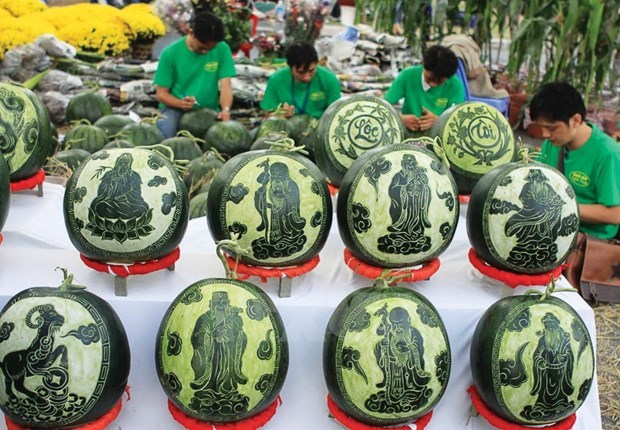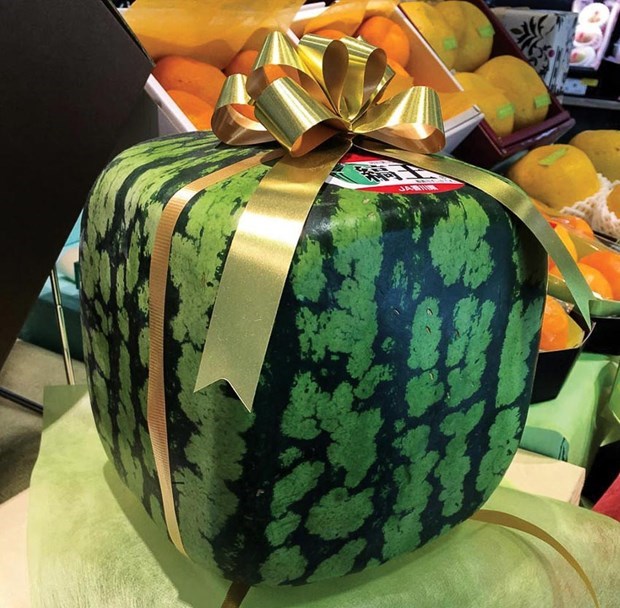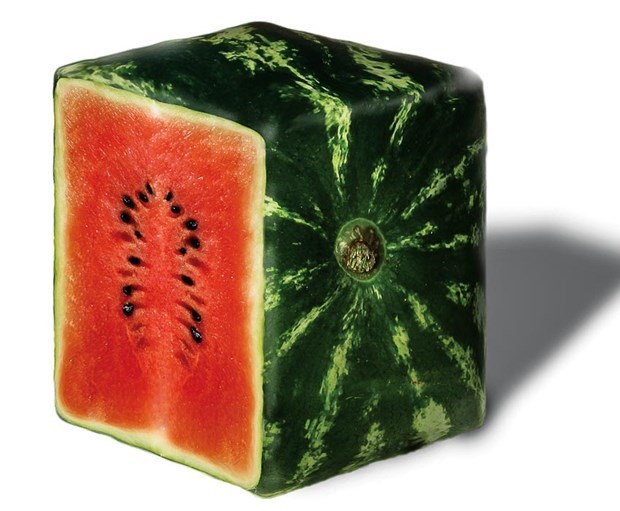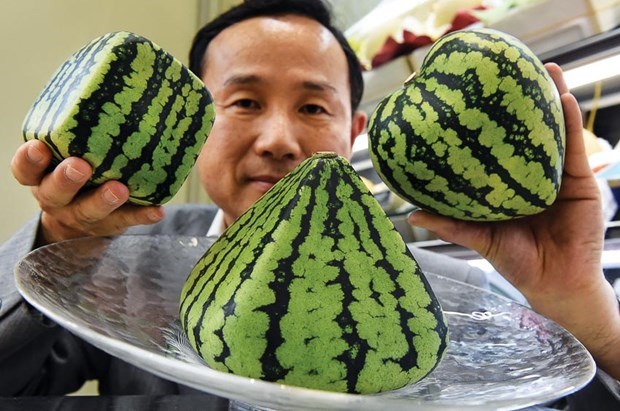Almost every household
would take at least a couple of watermelon to decorate the altar and normally,
the whole family would gather together to chop off a big watermelon. If the
watermelon flesh is red, it means that family would get good lucks all new year.
Regularly, watermelon has a round shape, representing the fulfillment while its
green skin symbolizes the freshness and youth, and red flesh refers to good
lucks, happiness, and beauty. However, during the changing of time, the
watermelon too has been changed to adapt to the new needs.

Carved watermelon.
Watermelon is a plant species in the family Cucurbitaceae,
a vine-like (scrambler and trailer) flowering plant originally from
sub-Saharan Africa. It is cultivated for fruits. Watermelon fruit has oval or
round shapes. There are scientific evidences that watermelon was planted
in the Nile Valley, Egypt from the second century BC, and archaeologists have
found watermelon seeds in Pharaoh Tutankhamun's catacomb. By the seventh
century, watermelons were grown in India and cultivated in China more than 11
centuries ago. The Moorish Muslims in Africa who conquered and invaded the
Iberian Peninsula (including most of Spain and Portugal today) for almost 800
years brought the watermelon to Europe. This sweet and nutritious fruit was
planted in Córdoba since 961 then in Seville in 1158. From the two Spanish
lands, the watermelon has spread to southern Europe and it has yielded where
has temperate climates.
Presented in European botanicals dating back to the
sixteenth century, watermelon was widely planted in local households’ backyards
in the seventeenth century then it followed the conquerors and local slaves to
the new land - America. At the same time, however, Native Americans also
cultivated watermelons along valleys of Mississippi and Florida, where the
climate and soil were perfect for watermelon’s development. The legendary
English explorer James Cook (1728-1779) brought watermelon to Hawaii and the
Pacific Islands, where the plant adapted quickly.
In our country, based on Linh
Nam chich quai – a collection of Vietnamese tales and legends compiled
around the end of Tran dynasty, watermelon had been there since King Hung period, meaning Vietnamese
watermelon was cultivated before Chinese types for a long time. The legend said
that the Father of watermelon in Vietnam was Mai An Tiem, who had been bought
by King Hung III since he was a
child. The boy grew up and became an important courtier of the King. He had
built his career up so high, making relationships with other courtiers.
However, Mai An Tiem also turned haughty. He said, “My
successful career is my karma. No one made me this way”. The King heard and he
got a rage, saying, “Such an arrogant and ungrateful subordinate! I shall send
you to a place of nowhere, surrounded by oceans, and I shall see what your
karma is”. The King expeled Mai An Tiem over the sea to a small remote island,
where had nothing but sands. Mai An Tiem was left with enough food for a short
time. Since his wife started crying, he said, “God never sends mouths but he
sends meat. Don’t worry”. One day, there was a big white bird from the west
landed off the island, loudly sang, and dropped some black seeds onto the sand.
From those seeds, vines had grown and bared lots of fruits. An Tiêm supposed
that was a gift for the family to survive so he opened one fruit and tasted.
Surprisingly, the fruit had refreshing and flavorful flesh. Since then, he
cultivated those vines to produce food and to trade with shipmen for rice. The
news ran like wild fire. Many ships and traders came to the island for those
fruits and the fruit had been spread widely. After a while, King Hung sent people to see how Mai An Tiem
living and when the King knew he was alive, he had been brought back to his
previous position by the King. People named the sandbank as An Tiem bank, where
nowadays belongs to Nga Son ward in Thanh Hoa province.
Due to the botanist's hybridization efforts, numbers of illness-resistant
varieties of watermelon and a nearly seedless watermelon (only small white beans,
which can be digested) are available. Even they have a watermelon type that can
bare fruits within 100 days after planting. However, the spectacular
transformation of watermelon took place exactly four decades ago. According to
unofficial sources, in 1978, a gardening and graphic artist named Tomoyuki Ono,
registered the invention of a "naturally molded fruits", in which Ono
found a way to place a young watermelon into a transparent square block so that
the melon grows only inside the mold and has a square shape finally. Tomoyuki
Ono's achievements were exhibited in an art gallery in Ginza (Tokyo), and later
expanded into pricy products - several times higher than regular watermelon in
local market. Tomoyuki Ono also registered his invention in the US, a big
market of square watermelons. How to make square melons was listed by CNN on
the list of important Japanese inventions that made the world change.

Squared watermelon gift in Japan.
Squared watermelon quickly becomes popular because they can
easily be stored and used. However, despite Tomoyuki Ono’s effort writing that
the flavor of squared watermelon is not any less than other normal types,
people have tended to keep squared watermelon for decoration and observing
rather than eating. The Japanese usually buy squared watermelon for special
occasions as other expensive fruits like Yubari cantaloupes, Ruby Roman red
seedless grapes, Taiyo no Tamago red
mangoes, or Sekai apples. Today, average price of a squared watermelon is about
US $100 in Tokyo. Afterward, Japanese farmers have created more shapes for
watermelon as heart or pyramid shapes.

Squared watermelon is easy for transportation, storing, and using.

Watermelon in different shapes: square, heart, and pyramid.
Recently, squared watermelon has appeared in Vietnam during
Tet holidays with much higher price compared to regular watermelon, of course.
People even carve on watermelon skin characters and images represented good
lucks, fortunes, and longevity.
By Golden Spoon Awards